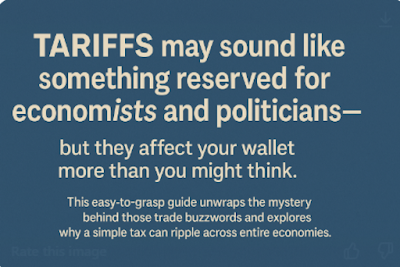Understanding Tariffs - A Simple but Comprehensive Guide
This information is also available on my YouTube Channel at: https://youtu.be/V-L208KideM
If you prefer, you can also listen to this information on my Podcast at: https://creators.spotify.com/pod/show/norbert-gostischa/episodes/Understanding-Tariffs---A-Simple-but-Comprehensive-Guide-e310ete
Tariffs are taxes or fees applied to goods when they're imported into a country or exported out of it. These levies can play a significant role in shaping a nation’s economy, impacting everything from consumer prices to international trade relationships. In this guide, we’ll dive deep into the world of tariffs, explaining what they are, why they’re used, and how they affect individuals and industries alike.
What Are Tariffs?
Tariffs can be thought of as a form of taxation, but instead of being levied on citizens, they’re applied specifically to goods. Import tariffs apply when foreign products enter a country, and export tariffs apply when domestic goods leave the country. The purpose of these taxes varies widely depending on who imposes them.
Why Are Tariffs Imposed?
Tariffs are imposed for various reasons:
1. Protecting Domestic Industries - Governments often impose protective tariffs to shield local industries from foreign competition. For example, a country might impose high tariffs on imported cars to encourage consumers to buy locally produced vehicles instead.
2. Generating Revenue - In some cases, tariffs are simply a way for the government to raise additional revenue. These revenue tariffs can be applied broadly to all imports, providing funds for public services and infrastructure projects.
3. Balancing Trade Deficits - Some countries impose tariffs to reduce trade deficits, which occur when other nations export more goods to their shores than they import. Tariffs can help level the playing field and encourage reciprocal trade practices.
How Do Tariffs Work?
Tariffs come in two primary forms:
1. Protective Tariffs - These are designed to protect local industries by making imported products more expensive. For instance, if a country imposes a 20% tariff on imported electronics, consumers will pay more for devices that are produced abroad.
2. Revenue Tariffs - Revenue tariffs are taxes levied directly on imports and exports. Unlike protective tariffs, revenue tariffs don’t target specific industries but instead generate income for the government by taxing all traded goods.
Who Benefits and Who Loses?
Tariffs have both winners and losers in the economic landscape:
Importers and Consumers - If a country imposes high tariffs on imported goods, consumers often feel the pinch. Higher prices on everything from clothing to machinery can make it more expensive for businesses and individuals alike.
Exporters - Domestic companies that export their products may face challenges if other countries impose tariffs on their goods. This can make their products more expensive in foreign markets, affecting their competitiveness.
Government - Revenue from tariffs directly benefits the government, which can use this money to fund public services or invest in infrastructure.
Alternatives to Tariffs
While tariffs are a common tool for managing trade, they’re not the only option. Governments can explore alternatives like:
1. Progressive Taxation - Instead of targeting specific goods with tariffs, governments can implement progressive taxation systems that ask higher-income individuals and corporations to pay more in taxes.
2. Fair Trade Agreements - These agreements aim to create a level playing field for all countries involved by eliminating unfair trade practices and reducing barriers to trade.
3. Export Subsidies - Instead of penalizing exporters with tariffs, governments can offer subsidies to help domestic companies compete on the global market.
Conclusion - A Balanced Approach
Tariffs are an important tool for managing trade relations, but they come with trade-offs. While they can protect local industries and generate revenue, they also increase prices for consumers and can harm exporters in other markets. By exploring alternatives like progressive taxation and fair trade agreements, governments can achieve their economic goals without penalizing citizens or damaging international relationships.
For us here in the US, tariffs go into effect today. Let's hope the reason for imposing those tariffs are accomplished quickly without too severe of an impact on both the consumers and industries. The objective is fair and balanced trade. Let's hope that's realized quickly and painlessly.
Final Thoughts
Understanding tariffs is crucial for anyone interested in economics or global trade. While the concept may seem complex at first, breaking it down into simple terms makes it accessible to everyone. Remember, the goal of any policy should be to benefit the greatest number of people while fostering a thriving economy.
(AI was used to aid in the creation of this article.)
"I’ll see you again soon. Bye-bye and thanks for reading, watching, and listening!"

.png)
Comments